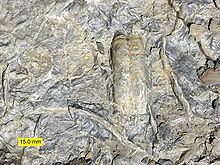Primary Quartzite, Conglomerate | Sub-units see text | |
 | ||
Thickness up to 2,180 metres (7,150 ft) Underlies | ||
The Gog Group is a stratigraphic unit in the Western Canada Sedimentary Basin. It is present in the western main ranges of the Canadian Rockies in Alberta and British Columbia, and in the Cariboo Mountains and in the central Purcell Mountains in southwestern British Columbia. It was named by C.F. Deiss in 1940 for a type locality near Mount Assiniboine.
Contents
Lithology and environment of deposition
The Gog Group consists primarily of thick deposits of cross-bedded quartzose sandstone and quartzite, with minor quartzitic conglomerate and sub-arkosic sandstone. It also includes mudstone, siltstone, limestone and dolostone formations. The Gog sediments are thought to have been deposited in shallow marine environments on the subsiding margin of the North American craton (Laurentia).
Subdivisions
The Gog Group is subdivided into the following formations:
Paleontology
Trace fossils such as Skolithos, Cruziana, Diplocraterion, Chondrites, Planolites, Rusophycus and others are abundant in the Gog Group sediments, and Early Cambrian trilobites of the genus Olenellus are found in the Peyto Formations limestones at the top of the Group. Small archaeocyathid bioherms have been reported from the base of the Mahato Formation, and archaeocyathids, salterellids, primitive brachiopods and echinoderms have been reported from the Mural Formation.
